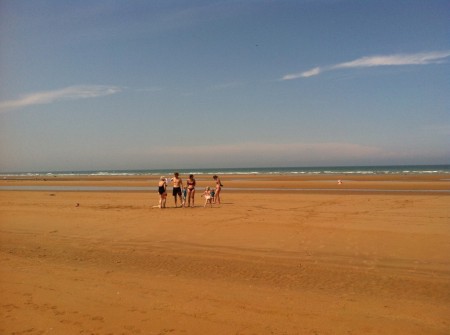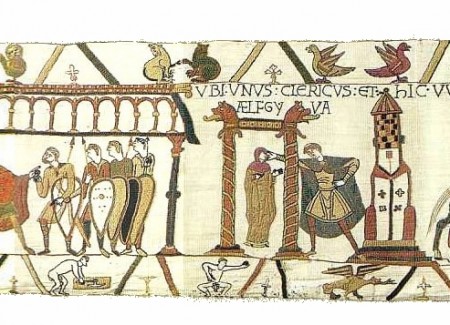It’s Sunday and we’re at the airport, heading home. It’s been an amazing trip.
We left Lyon for Normandy on Wednesday. On the way, we stopped overnight in the Loire region and visited Chenonceaux, a Renaissance chateau that belonged to Catherine de Medici.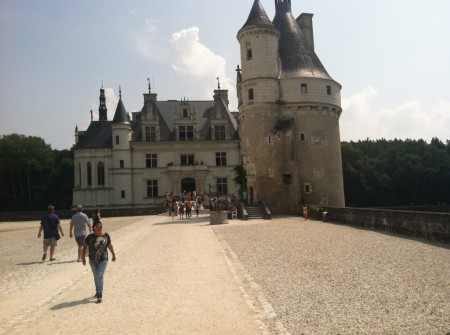 Actually, it wasn’t hers originally. Catherine’s husband, Henri II, presented it to his mistress, Diane de Poitiers, which rankled Catherine to no end. After he was killed in a freakish jousting accident, Catherine wasted little time bunging Diane out of Chenonceaux. Catherine told Diane she would swap it for a different chateau, named Chaumont, but when Diane entered Chaumont, she found Catherine had had it redecorated with Satanical pentagrams as part of the motif, and Diane was so freaked out, she never returned to it.
Actually, it wasn’t hers originally. Catherine’s husband, Henri II, presented it to his mistress, Diane de Poitiers, which rankled Catherine to no end. After he was killed in a freakish jousting accident, Catherine wasted little time bunging Diane out of Chenonceaux. Catherine told Diane she would swap it for a different chateau, named Chaumont, but when Diane entered Chaumont, she found Catherine had had it redecorated with Satanical pentagrams as part of the motif, and Diane was so freaked out, she never returned to it.
On Thursday we visited the magnificent 12th century Abbey of Fontevraud, where Eleanor of Aquitaine is entombed. Here she is, next to her husband, Henri Plantagenet: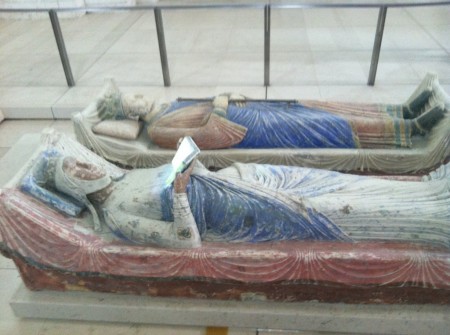 Their son, Richard the Lionhearted, is also entombed there, except that this is just one of three burial sites for him. His body was divided up and buried in three different places: his heart was sent to one place and his brain and guts to another.
Their son, Richard the Lionhearted, is also entombed there, except that this is just one of three burial sites for him. His body was divided up and buried in three different places: his heart was sent to one place and his brain and guts to another.
At Bayeux, we visited the famous tapestry. It’s actually not a tapestry (which is by definition woven). It’s an embroidered cloth, magnificent to see in real life. Nine centuries old and 70 meters long, it depicts the events surrounding the Norman conquest of England and the Battle of Hastings, in 1066. At that battle, William, Duke of Normandy, aka William the Bastard (long story) defeated Harold, King of England, and William became known as William the Conqueror. And French became the official language in England for the next three hundred years.
You can see the whole panel here, but I made a beeline for panel 15, because I’ve always been curious about the two mysterious naked guys and was excited to see them in, er, the flesh. Medieval scholars have argued endlessly about this scene. Why is there a naked guy smoothing wood with a sharp, dangerously situated blade? And who is the woman in the main panel, getting slapped by the guy in the cape? And why is there another naked guy in the margin art, just below her? She’s one of only two women in the entire tapestry, and the embroidered caption says: Ubi unus clericus et Ælfgyva, which translates roughly as: Hey, look. It’s a clerk and Ællfgyva. According to the audio guide, Ællfgyva was Harold’s daughter and it’s Harold who is smacking her, because she got herself engaged to William. Or maybe it’s the other way around and she’s getting slapped by William for getting engaged to Harold. Some scholars think the second naked guy may just be a naughty joke thrown in by one of the embroiderers, or he may be her lover hiding under the floorboards, or the first naked guy may symbolize Harold in a precarious predicament and the second one is Harold boasting and acting—literally I suppose—too big for his britches, before he proceeds to get trounced by William later in the tapestry. If you have another theory, please let us know in the comment section.
On Friday we spent a somber day driving around Normandy, viewing the D-Day battle sites and cemeteries (both American and German) with our amazingly knowledgeable and lovely guide, Claire. Here she is with Jon: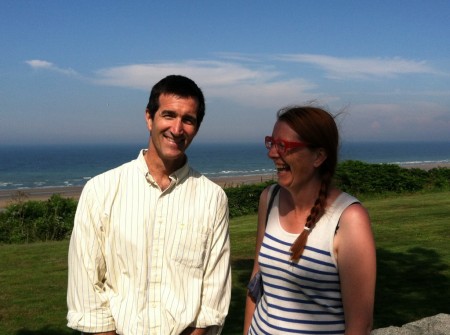 And here’s Omaha beach, one of the D-day landing sites, which is spectacularly beautiful, and haunting.
And here’s Omaha beach, one of the D-day landing sites, which is spectacularly beautiful, and haunting. I was surprised to see that it was open to the beach-going public, and that there were some people swimming there. But Claire said that WWII veterans she has toured have told her they’re glad that French people use the beaches recreationally, as it reinforces why they fought that day.
I was surprised to see that it was open to the beach-going public, and that there were some people swimming there. But Claire said that WWII veterans she has toured have told her they’re glad that French people use the beaches recreationally, as it reinforces why they fought that day.